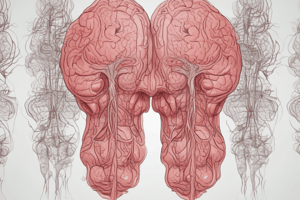Podcast
Questions and Answers
Which factor does not contribute to the prevention of stroke?
Which factor does not contribute to the prevention of stroke?
- Maintaining a healthy weight
- Exercising regularly
- Lowering dietary intake of fiber (correct)
- Controlling high blood pressure
What is the primary goal of acute care for stroke patients?
What is the primary goal of acute care for stroke patients?
- To enhance brain injury and restore prior functioning
- To minimize brain injury and maximize recovery (correct)
- To ensure long-term rehabilitation success
- To stabilize chronic conditions like diabetes
Which of the following is an essential step in the acute care stage for stroke management?
Which of the following is an essential step in the acute care stage for stroke management?
- Long-term lifestyle changes
- Regular follow-ups at a stroke center
- Immediate recognition and response to stroke symptoms (correct)
- Continuous observation of heart rate
What does the National Institutes of Health Stroke Scale assess?
What does the National Institutes of Health Stroke Scale assess?
Which imaging test is primarily used to assess damage after a stroke?
Which imaging test is primarily used to assess damage after a stroke?
What is a critical component when diagnosing a stroke?
What is a critical component when diagnosing a stroke?
Which of the following is not one of the measures taken in acute stroke care?
Which of the following is not one of the measures taken in acute stroke care?
What role does rehabilitation play after a stroke?
What role does rehabilitation play after a stroke?
Why should anticoagulant and antiplatelet medications never be given to a patient with a hemorrhagic stroke?
Why should anticoagulant and antiplatelet medications never be given to a patient with a hemorrhagic stroke?
What is the maximum permissible systolic blood pressure for a patient eligible for thrombolytic therapy with IV tPA?
What is the maximum permissible systolic blood pressure for a patient eligible for thrombolytic therapy with IV tPA?
Which medication may be prescribed to manage cerebral edema in stroke patients?
Which medication may be prescribed to manage cerebral edema in stroke patients?
What is the primary action of tissue plasminogen activator (tPA) in stroke treatment?
What is the primary action of tissue plasminogen activator (tPA) in stroke treatment?
How long after symptom onset is alteplase most effective when used to treat ischemic stroke?
How long after symptom onset is alteplase most effective when used to treat ischemic stroke?
What should be monitored continuously in a patient receiving tPA therapy to watch for complications?
What should be monitored continuously in a patient receiving tPA therapy to watch for complications?
What is a common complication of tPA therapy?
What is a common complication of tPA therapy?
What dietary advice should patients receiving tPA follow?
What dietary advice should patients receiving tPA follow?
Which surgical procedure may be performed to treat significant atherosclerosis in stroke patients?
Which surgical procedure may be performed to treat significant atherosclerosis in stroke patients?
Why is blood pressure control important during the acute phase of stroke?
Why is blood pressure control important during the acute phase of stroke?
What informs the decision to perform an extracranial–intracranial bypass?
What informs the decision to perform an extracranial–intracranial bypass?
What is an essential nursing action before administering tPA?
What is an essential nursing action before administering tPA?
When should patients ideally receive tPA after arriving in the emergency department?
When should patients ideally receive tPA after arriving in the emergency department?
What type of stroke is characterized by an immediate appearance of clinical symptoms?
What type of stroke is characterized by an immediate appearance of clinical symptoms?
What imaging test can identify cerebral ischemia immediately after stroke onset?
What imaging test can identify cerebral ischemia immediately after stroke onset?
Which medication is commonly used to prevent clot formation in patients with a history of stroke?
Which medication is commonly used to prevent clot formation in patients with a history of stroke?
What is the recommended timeframe for administering tPA for optimal effectiveness in treating acute ischemic stroke?
What is the recommended timeframe for administering tPA for optimal effectiveness in treating acute ischemic stroke?
What type of drug is generally prescribed to manage high blood pressure in the context of stroke prevention?
What type of drug is generally prescribed to manage high blood pressure in the context of stroke prevention?
Which of the following tests is NOT included in imaging techniques for stroke diagnosis?
Which of the following tests is NOT included in imaging techniques for stroke diagnosis?
Which medication class is considered standard for cholesterol management in stroke prevention?
Which medication class is considered standard for cholesterol management in stroke prevention?
What should be avoided in patients with increased intracranial pressure (ICP)?
What should be avoided in patients with increased intracranial pressure (ICP)?
What therapy is recommended for patients with atrial fibrillation to prevent stroke?
What therapy is recommended for patients with atrial fibrillation to prevent stroke?
What effect does daily low-dose aspirin have for patients with TIAs?
What effect does daily low-dose aspirin have for patients with TIAs?
Which of the following is considered a contraindication for tPA administration?
Which of the following is considered a contraindication for tPA administration?
In terms of stroke prevention, what is the primary effect of antihypertensive medications?
In terms of stroke prevention, what is the primary effect of antihypertensive medications?
What type of stroke is the use of thrombolytic agents particularly indicated for?
What type of stroke is the use of thrombolytic agents particularly indicated for?
Which of the following medications is a direct thrombin inhibitor used for stroke prevention?
Which of the following medications is a direct thrombin inhibitor used for stroke prevention?
Flashcards are hidden until you start studying
Study Notes
Stroke Treatment Stages
- Stroke treatment consists of three stages: prevention, acute care, and rehabilitation.
- Prevention focuses on managing risk factors like high blood pressure, cholesterol, diabetes, smoking, and maintaining a healthy weight.
- Acute care aims to diagnose the stroke type, support brain circulation, and prevent further complications.
- Rehabilitation focuses on recovery and regaining lost function through specialized therapy.
Diagnosing a Stroke
- Stroke diagnosis involves observation, patient history, a physical examination, including a neurological assessment, and imaging tests.
- The National Institutes of Health Stroke Scale (NIHSS) assesses neurological function and recovery.
- Imaging tests, including CT scans, MRI, and cerebral arteriography, help identify stroke-related changes and differentiate between hemorrhagic and ischemic strokes.
- Blood tests, like the PLAC test, are used to assess the risk for recurrent stroke.
Medications for Stroke Prevention
- Antiplatelet agents like aspirin and clopidogrel are used to reduce the risk of stroke in individuals with a history of TIAs or stroke.
- Anticoagulants like warfarin, rivaroxaban, apixaban, edoxaban, and dabigatran are prescribed to prevent stroke in patients with atrial fibrillation.
- Antihypertensive medications, including thiazide diuretics, calcium channel blockers, ACE inhibitors, and ARBs, are used to manage high blood pressure and reduce stroke risk.
- Cholesterol-lowering drugs, such as statins and fibric acid agents, are prescribed to manage high cholesterol levels.
Medications for Acute Stroke
- Anticoagulants, platelet inhibitors, and thrombolytic agents are used to treat thrombotic strokes.
- Thrombolytic therapy with alteplase (tPA) is considered the gold standard for treating acute ischemic stroke.
- tPA is most effective when administered intravenously within 3 hours of stroke onset, but can be given up to 4.5 hours in specific cases.
- Aspirin may be used in patients who are contraindicated for tPA.
- Anticoagulants and antiplatelet agents are not used in patients with hemorrhagic stroke.
- Corticosteroids, such as prednisone or dexamethasone, may be prescribed for cerebral edema.
- Osmotic diuretics (mannitol) and loop diuretics (furosemide) may be given for increased intracranial pressure.
- Anticonvulsants, such as phenytoin and barbiturates, may be prescribed for seizures related to increased ICP.
Surgical Interventions
- Carotid endarterectomy is a surgical procedure to remove atherosclerotic plaque from the carotid artery bifurcation to improve blood flow.
- Extracranial-intracranial bypass surgery is performed to re-establish blood flow to the brain in cases of occluded or stenotic vessels.
- Carotid angioplasty with stenting can be used to treat cerebral stenosis.
Rehabilitation Therapies
- Physical therapy focuses on preventing contractures, improving muscle strength, and enhancing coordination.
- Occupational therapy helps patients regain lost motor skills, such as eating, bathing, and dressing.
- Speech and language therapy assists with relearning language and communication skills, as well as improving swallowing.
Studying That Suits You
Use AI to generate personalized quizzes and flashcards to suit your learning preferences.





